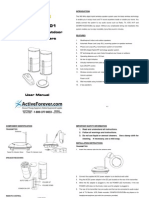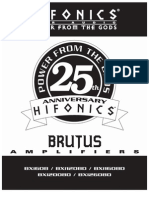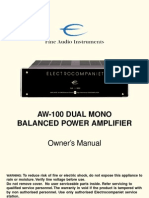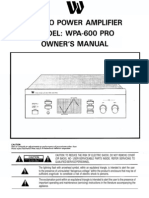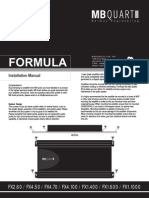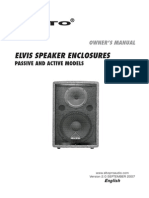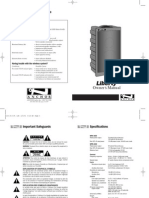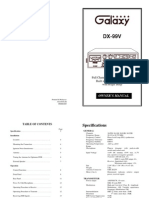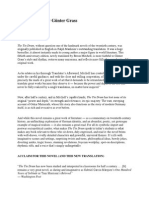Maxi Mouse User Manual
Maxi Mouse User Manual
Uploaded by
jcatfordCopyright:
Available Formats
Maxi Mouse User Manual
Maxi Mouse User Manual
Uploaded by
jcatfordOriginal Description:
Original Title
Copyright
Available Formats
Share this document
Did you find this document useful?
Is this content inappropriate?
Copyright:
Available Formats
Maxi Mouse User Manual
Maxi Mouse User Manual
Uploaded by
jcatfordCopyright:
Available Formats
MAXI MOUSE SMT
PORTABLE AMPLIFIER
LECTROSONICS, INC.
Rio Rancho, NM
OPERATING INSTRUCTIONS
and trouble-shooting guide
2
3
Portable Amplifier
Rio Rancho, NM USA
TABLE OF CONTENTS
INTRODUCTION..................................................................................................... 2
GENERAL TECHNICAL DESCRIPTION ............................................................... 3
INSTALLATION ....................................................................................................... 4
FRONT PANEL DESCRIPTION............................................................................. 5
REAR PANEL DESCRIPTION ............................................................................... 6
OPERATING INSTRUCTIONS............................................................................... 8
REMOTE LEVEL CONNECTIONS ........................................................................ 9
TROUBLESHOOTING............................................................................................ 9
SERVICE AND REPAIR....................................................................................... 10
RETURNING UNITS FOR REPAIR ..................................................................... 10
SPECIFICATIONS................................................................................................ 11
APPENDIX 1: SERIAL PORT HARDWARE AND SOFTWARE ......................... 12
SERIAL PORT COMMANDS AVAILABLE.......................................................... 13
WARRANTY............................................................................................ Back cover
INTRODUCTION
Mouse was introduced to the Music Industry in 1979. It was the first rechargeable,
portable amp with enough power to satisfy the demands of the professional. It puts
out more sound than anything near its size. Since that time, the Mouse has continued
to be the Number One choice of street musicians throughout the world, and will be
found sitting around the studios of some of the finest guitarists in the world.
The Maxi Mouse model was introduced to the Music Industry in 1984 as a step up
from the Lectrosonics Mouse. The Maxi offered more power, more inputs and con-
trols, and a unique high-efficiency power supply that quickly established it as a
suitable partner for Mouse. The Maxi Mouse has tone and equalization controls which
offer the performer a truly wide range of settings.
Now, in 1994, Lectrosonics is introducing the Maxi Mouse SMT. In addition to all the
great features of the Maxi Mouse, the Maxi Mouse SMT is manufactured using
surface mount technology resulting in a much more reliable and long lasting product.
4
GENERAL DESCRIPTION
The Maxi Mouse SMT is a rechargeable battery operated, dual input amplifier. It is designed to be both a high output
instrument amplifier and a very versatile voice amplifier. Designed with a special signal processor, it will put out as
much sound as amplifiers with much higher ratings. Switchable input equalization allows using maximum gain with
microphones, and better fidelity when used with instruments. By moving the equalization switch to the appropriate
position, it is possible to run any type of audio source into the Maxi, from microphones to tape decks. This is why
Maxi Mouse is also used as a general utility amplifier, to amplify everything from a VCR to a walkman type portable
stereo, in locations ranging from a hotel ballroom to the beach.
Both the Mouse and Maxi Mouse are designed to operate from the built-in battery pack. The Heavy duty batteries are
designed for heavy use and provide a pure, stable DC power source. A line output allows running an external speaker
or patching the Maxi Mouse into another amplifier or mixing console.
IMPORTANT
FAILURE TO OBSERVE THE FOLLOWING PRECAUTIONS CAN CAUSE PREMATURE BATTERY FAILURE.
BATTERY FAILURE CAUSED BY NEGLECT OR MISUSE IS NOT COVERED BY THE WARRANTY.
It is very important to recharge the battery pack immediately after the unit is used. The battery pack is charged by
plugging the CH-40 charger into the jack labeled CHARGE on the control panel of the unit. Connect the charger into a
standard 110 Volt, 60Hz AC outlet. The green lamp beneath the jack will light as long as the batteries are charging.
When the batteries are almost completely charged the green charging light will go out. You may leave the charger
plugged in after the green light has gone out with no danger of damage to the system. In fact, we recommend charging
the system whenever it is not in use, then the system will always be ready to go.
5
Portable Amplifier
Rio Rancho, NM USA
10Hz 100Hz 1KHz 10KHz 20KHz
0dB
+4
+8
+12
-4
-8
-12
+16
+20
MAX
MIN
MID
MAXI MOUSE FREQUENCY RESPONSE
"INST" EQUALIZATION
EFFECT OF TONE CONTROL POSITION
"VOICE" EQUALIZATION
MAXI MOUSE FREQUENCY RESPONSE
+20
+16
-12
-8
-4
+12
+8
+4
0dB
10KHz 1KHz 100Hz 10Hz
MIN
MID
MAX
EFFECT OF TONE CONTROL POSITION
MIN
20KHz
Operation is possible while charging the batteries with the supplied CH-40 charger, however since the amplifier con-
sumes more power than the CH-40 charger can supply, the batteries will recharge faster if you turn the amplifier power
off while charging.
The battery pack should be recharged for 16 hours at least once every six months even when the unit is in storage and
not being used.
In many cases, a battery that seems to be dead may be saved by prolonged charging. As much as 10 days of
continuous charging may be necessary to restore the batteries after they have been left for several weeks or more in a
discharged condition. The charge lamp may not light up during the first part of a prolonged charging period.
6
CONTROLS AND FUNCTIONS
INPUTS AND VOLUME CONTROL
INPUTS A and B are standard 1/4" phone jacks which may be used with either an instrument or a high impedance
microphone. These are switching jacks that turn on the amplifier when you plug in your instrument cord. The input
impedance is 10 megohms to match any type of instrument pickup. When used with low impedance microphones, a
matching transformer should be used to convert the microphone output to high impedance. A suitable matching
transformer is readily available at music stores or electronics dealers in your area.
Each input on the Maxi Mouse has a separate VOLUME and TONE control for individual adjustment of each channel.
The MASTER VOLUME control adjusts the total output of the amplifier
EQUALIZATION SWITCH
This three position switch changes the frequency response of the inputs. In the left-most position, both inputs A and B
have a frequency response with reduced mid-range and boosted bass and treble. The INST equalization generally
sounds better for almost any type of instrument when there are no other signal processors (effects boxes) in use. The
center position sets input A to a flat response and input B to the INST equalized response. The right-most position
sets both inputs to a flat response.
MASTER VOLUME
For a flat, clean type of sound or when used with microphones, set the MASTER VOLUME control to VOICE RANGE
or fully clock-wise, and adjust the loudness of each input with the volume control next to each input jack.
A distorted (over-driven) sound is produced by setting the MASTER VOLUME counter-clockwise to a lower position
and turning the input volume up to near maximum. When either input is set for a distorted, over-driven sound, the
sound from both inputs will be distorted.
SPEAKER OUTPUT
This output jack accepts a standard 1/4" phone plug. When the plug is inserted fully, the output will drive a 2 to 4 Ohm
speaker. The jack is also equipped with a detent that allows the plug to be inserted half-depth, providing a line output
for connecting into another amplifier or tape recorder with an input impedance of about 10K Ohms.
CHARGE JACK
To charge the Maxi Mouse, insert the charger plug fully into the CHARGE jack on the control panel, and plug the CH-
40 charger into a 110 Volt wall outlet. The green LED above the CHARGE jack will light up when the unit is taking a
charge. Leave the charger connected in this manner until the green LED goes out, indicating that the batteries are fully
charged. You may leave the charger plugged in after the green light has gone out with no danger of damage to the
system. In fact, we recommend charging the system whenever it is not in use, then the system will always be ready
to go. A fully discharged battery pack will take about 12 hours to recharge.
7
Portable Amplifier
Rio Rancho, NM USA
TROUBLESHOOTING GUIDE
BEFORE GOING THROUGH THE FOLLOWING CHART, BE SURE THE BATTERY PACK IS FULLY CHARGED. The
POWER LAMP should light up when the unit comes on. The POWER LAMP will grow dim as the batteries discharge.
Keep the batteries fully charged when not in use to insure long battery life. Continuous charging will not harm the
battery pack, although it is not necessary. In extreme cases a continuous charge of ten days may be necessary to
restore a deeply discharged battery pack. If the battery pack still will not except a charge after ten days then the pack
will need to be replaced. See page 2 for charging instructions.
It is important to follow these steps in the sequence listed.
SYMPTOM POSSIBLE CAUSE
POWER LAMP NOT ON 1) Amplifier turned off. Check that input cable is fully plugged in.
2) Battery pack discharged. Recharge unit.
CHARGING LAMP NOT ON WITH
PLUGGED INTO CHARGE JACK 1) CH-40 not plugged into 110V supply.
2) 110V supply switched off or defective. Check 110V outlet for
voltage by plugging in a lamp or other AC device.
3) CH-40 charger defective.
NO SOUND FROM SPEAKER 1) Volume turned down. Check Volume control.
2) Input cable not plugged in.
3) Mic muted. Check mute switch on microphone body if this
feature is included on your equipment.
4) Defective mic or cable.
INTERMITTENT AUDIO OR CRACKLING
SOUND FROM SPEAKER 1) Defective mic or cable. Try different mic and cable.
2) Dirty cable plugs. Clean cable ends with clean alcohol and a
clean soft cloth. A brand new cord stored in a sealed container
such as a plastic bag will give off a gas that forms a coating
on the plugs (outgassing). This coating can cause improper
contact when the plug is connected to the jack on the equip
ment. It will appear that the cord is defective. It is a good idea
to clean the cord periodically, and after the system has been
stored. Clean the plugs with alcohol and a clean cloth.
DISTORTED SOUND FROM SPEAKER 1) Volume set too high. Reduce volume control.
2) Excessive wind noise or breath pops.
3) Batteries very low. Recharge batteries. As the batteries
discharge you have to turn up the volume. When the volume
knob is turned all the way up and youre still not getting much
volume out of the system, the amplifier is being driven to its
limit and usually produces distorted sound.
EXCESSIVE FEEDBACK 1) Volume too high. Reduce volume control.
2) Microphone too far from sound source (requiring the volume to
be turned up to compensate). Speak closer to the mic or
move mic closer to sound source.
3) Microphone too close to, or directly in front of, the speaker.
The unit should be placed between you and the crowd. If you
stand in front of the unit while you use it, feedback can occur.
This problem is easily solved by moving behind the unit as you
speak.
8
SPECIFICATIONS
AMPLIFIER
Type: All silicon transistor
Power: 9 Watts, RMS, into 2 Ohms
Distortion: Less than 1%
Frequency response: 50Hz to 20kHz Hz 1dB
Equivalent input noise: -120dBv
Input impedance: 10 megohm-matches high impedance microphones and
instrument pickups
Output impedance: Speaker - 2 Ohms, External amplifier - 10K Ohm
SPEAKER
Type: Full range
Size: 8-inch with 2-pound magnet assembly and 2 Ohm voice coil
POWER SOURCE Rechargeable 12 Volt, lead-acid gel cell, 4 Amp-hour self-
contained battery pack. CH-40 charger included.
SIZE 9 1/2" high x 12" wide x 10" deep
WEIGHT 13 pounds
ACCESSORY COVER, Optional, Model P-MM
A heavy-duty, naugahyde slip cover with a convenient zippered pouch large enough to store the
charger, guitar cords and effect devices.
Specifications subject to change without notice.
9
Portable Amplifier
Rio Rancho, NM USA
SERVICE AND REPAIR
If your system malfunctions, you should attempt to correct or isolate the trouble before concluding that the equipment
needs repair. Make sure you have followed the setup procedure and operating instructions. Check out the intercon-
necting cords and then go through the TROUBLE SHOOTING section in the manual
We strongly recommend that you do not try to repair the equipment yourself and do not have the local repair shop
attempt anything other than the simplest repair. If the repair is more complicated than a broken wire or loose connec-
tion, send the unit to the factory for repair and service. Dont attempt to adjust any controls inside the units. Once set
at the factory, the various controls and trimmers do not drift with age or vibration and never require readjustment.
There are no adjustments inside that will make a malfunctioning unit start working.
LECTROSONICS service department is equipped and staffed to quickly repair your equipment. In warranty repairs are
made at no charge in accordance with the terms of the warranty. Out of warranty repairs are charged at a modest flat
rate plus parts and shipping. Since it takes almost as much time and effort to determine what is wrong as it does to
make the repair, there is a charge for an exact quotation. We will be happy to quote approximate charges by phone for
out of warranty repairs.
RETURNING UNITS FOR REPAIR
You will save yourself time and trouble if you will follow the steps below:
A. DO NOT return equipment to the factory for repair without first contacting us by letter or by phone. We need to
know the nature of the problem, the model number and the serial number of the equipment. We also need a phone
number where you can be reached 8 am to 4 pm (Mountain Standard Time).
B. After receiving your request, we will issue you a return authorization number (R.A.). This number will help speed
your repair through our receiving and repair departments. The return authorization number must be clearly shown on
the outside of the shipping container.
C. Pack the equipment carefully and ship to us, shipping costs prepaid. If necessary, we can provide you with the
proper packing materials. UPS is usually the best way to ship the units. Heavy units should be double-boxed for
safe transport.
D. We also strongly recommend that you insure the equipment, since we cannot be responsible for loss of or damage
to equipment that you ship. Of course, we insure the equipment when we ship it back to you.
Mailing address: Shipping address: Telephones:
Lectrosonics, Inc. Lectrosonics, Inc. Regular: (505) 892-4501
PO Box 15900 581 Laser Rd. Toll Free (800) 821-1121
Rio Rancho, NM 87174 Rio Rancho, NM 87124 FAX: (505) 892-6243
USA USA
World Wide Web: http://www.lectrosonics.com Email: sales@lectrosonics.com
LIMITED ONE YEAR WARRANTY
The equipment is warranted for one year from date of purchase against defects in
materials or workmanship provided it was purchased from an authorized dealer. This
warranty does not cover equipment which has been abused or damaged by careless
handling or shipping. This warranty does not apply to used or demonstrator equip-
ment.
Should any defect develop, we will, at our option, repair or replace any defective
parts without charge for either parts or labor. If we cannot correct the defect in your
equipment, we will replace it at no charge with a similar new item. We will pay for the
cost of returning your merchandise to you.
This warranty applies only to items returned to us, shipping costs prepaid, within one
year from the date of purchase.
This warranty gives you specific legal rights. You may have additional legal rights
which vary from state to state.
LECTROSONICS, INC.
581 LASER ROAD
RIO RANCHO, NM 87124 USA
July 7, 1999
You might also like
- Koechlin Sonatine Modale Op.155Document10 pagesKoechlin Sonatine Modale Op.155EmmaNo ratings yet
- NuagesDocument1 pageNuagesjcatfordNo ratings yet
- Tiefel - Great Choral RehearsalsDocument24 pagesTiefel - Great Choral Rehearsalsjzlgtz100% (16)
- Memphis Car AudioDocument16 pagesMemphis Car AudioInstalaciones Caraudio100% (2)
- Audiolab 8000A Owner's Manual PDFDocument10 pagesAudiolab 8000A Owner's Manual PDFRastko ManojlovicNo ratings yet
- Audio Unlimited Wireless Speakers ManualDocument6 pagesAudio Unlimited Wireless Speakers ManualMinh Long ĐỗNo ratings yet
- Speak LowDocument1 pageSpeak Lowjcatford100% (1)
- BXi 08 Amplifier ManualDocument12 pagesBXi 08 Amplifier ManualOscar ValdiviaNo ratings yet
- RX2.400 RX2.300 RX2.200 RX2.150 RX2.100 RX4.400 RX4.300 RX4.200 RX5.600Document20 pagesRX2.400 RX2.300 RX2.200 RX2.150 RX2.100 RX4.400 RX4.300 RX4.200 RX5.600JoseAlfredoGarciaRuizNo ratings yet
- Tri EngDocument22 pagesTri EngAndré Oliveira100% (1)
- A Low-Noise High-Output Capacitor Mic SystemDocument6 pagesA Low-Noise High-Output Capacitor Mic SystemDavid KaneNo ratings yet
- Gemini Sound X-2 Service ManualDocument24 pagesGemini Sound X-2 Service Manualbizzinifra5522No ratings yet
- TLAudio 2fat GuideDocument32 pagesTLAudio 2fat Guidejanoo74100% (2)
- Swing GitaneDocument1 pageSwing GitanejcatfordNo ratings yet
- Ornamentation and Style in Italian Late Renaissance and BaroqueDocument34 pagesOrnamentation and Style in Italian Late Renaissance and BaroqueAnna AnnieNo ratings yet
- Coustic Amp ManualDocument19 pagesCoustic Amp ManualVincent TonNo ratings yet
- Operating Manual: AmplifierDocument12 pagesOperating Manual: AmplifiermigfrayaNo ratings yet
- Electric Acoustic Guitar: Owner's ManualDocument2 pagesElectric Acoustic Guitar: Owner's ManualReinaldy RafliNo ratings yet
- Peavey Bandit 112 (Silverstripe / Black Box) Users ManualDocument20 pagesPeavey Bandit 112 (Silverstripe / Black Box) Users Manualb0beiii100% (4)
- AW100DMBDocument8 pagesAW100DMBchan_thong_1No ratings yet
- Stereo Power Amplifier Model: Wpa-600 Pro Owner'S ManualDocument6 pagesStereo Power Amplifier Model: Wpa-600 Pro Owner'S ManualGay InkognitoNo ratings yet
- Rev. ADocument12 pagesRev. AArto SillanpääNo ratings yet
- AER Compact 60 - User ManualDocument8 pagesAER Compact 60 - User ManualcairobluesNo ratings yet
- User and Installation Guide: 2.4 GHZ Digital Wireless HeadphonesDocument8 pagesUser and Installation Guide: 2.4 GHZ Digital Wireless Headphonesm540No ratings yet
- Om MTX X702Document36 pagesOm MTX X702Nicolae EnacheNo ratings yet
- Vox AC15-30 Handwired InstructionsDocument28 pagesVox AC15-30 Handwired InstructionsGuitar RoomNo ratings yet
- Battalion ManualDocument8 pagesBattalion Manuallubo10569No ratings yet
- Smart Belle Manual-V2Document12 pagesSmart Belle Manual-V2Tony bonyNo ratings yet
- Chaosexxtreme Ab en UmDocument21 pagesChaosexxtreme Ab en UmEnzo CeballosNo ratings yet
- TSW60Document7 pagesTSW60Karloof AutencioNo ratings yet
- ManualDocument16 pagesManualDenis MolotovNo ratings yet
- P Series Power Zone 08 Amp ManualDocument15 pagesP Series Power Zone 08 Amp ManualAngel Legna0% (2)
- Owner's Manual 240SE, 400SE, & 600SE: For Two Channel Power AmplifiersDocument11 pagesOwner's Manual 240SE, 400SE, & 600SE: For Two Channel Power AmplifiersSima PurkovNo ratings yet
- MB Quart Formula Amplifier ManualDocument11 pagesMB Quart Formula Amplifier ManualconganthonNo ratings yet
- ARES II User Manual A2 230222Document16 pagesARES II User Manual A2 230222Jose Gerardo Rivera RamirezNo ratings yet
- Sony Xm-2200gtx SMDocument24 pagesSony Xm-2200gtx SMMauricio Trujillo PazNo ratings yet
- HceampsDocument20 pagesHceampsapi-290101261No ratings yet
- Solstice ManualDocument8 pagesSolstice ManualscribdloucoNo ratings yet
- Toft Audio EC-1 Mono Channel ManualDocument6 pagesToft Audio EC-1 Mono Channel ManualPhasebookerNo ratings yet
- Owner's ManualDocument12 pagesOwner's ManualpepinNo ratings yet
- ALTO Zvucnici SpecifikacijeDocument23 pagesALTO Zvucnici SpecifikacijeGoran Ristic-RileNo ratings yet
- cock-fight-plus-manualDocument4 pagescock-fight-plus-manualMárcio AlmeidaNo ratings yet
- Peq 70 eDocument12 pagesPeq 70 eapi-290101261No ratings yet
- Midland Alan 121 ManualDocument13 pagesMidland Alan 121 ManualPascal PrekerNo ratings yet
- Fender BXR 100Document7 pagesFender BXR 100Javier Lacambra LapiedraNo ratings yet
- 50W Guitar Amplifier: User's ManualDocument13 pages50W Guitar Amplifier: User's Manualdss-manNo ratings yet
- Home HTTPD Data Media-Data 2 ManualDocument16 pagesHome HTTPD Data Media-Data 2 ManualComunicação de EducaçãoNo ratings yet
- Anchor Lliberty Mpa ManDocument8 pagesAnchor Lliberty Mpa ManIgnacio Barriga NúñezNo ratings yet
- Manual Mesa PHONIC AM240 AM240D en EsDocument28 pagesManual Mesa PHONIC AM240 AM240D en EsJuanmaNo ratings yet
- Manual Usuario tr100.2Document48 pagesManual Usuario tr100.2alvarocoches68No ratings yet
- Manual VZ 24Document16 pagesManual VZ 24Andrelly VLNo ratings yet
- Golden Master 3U 1U ManualDocument13 pagesGolden Master 3U 1U ManualCora MedinaNo ratings yet
- Sound Column Lectern Model S500-Mh/Mo/Ok/Wt Includes:: Public Address SystemDocument2 pagesSound Column Lectern Model S500-Mh/Mo/Ok/Wt Includes:: Public Address SystemElla MariaNo ratings yet
- Eden WT550 AmpDocument17 pagesEden WT550 AmptwspalmNo ratings yet
- Operation Manual / Bedienungsanleitung: Nearfield MonitorDocument32 pagesOperation Manual / Bedienungsanleitung: Nearfield Monitorricardo_musicaNo ratings yet
- Sony Wireless Headphones ManualDocument2 pagesSony Wireless Headphones ManualSteve DitchburnNo ratings yet
- Owner'S Manual: Full Channel AM/FM/SSB Mobile Built in Frequency Counter With Roger BeepDocument10 pagesOwner'S Manual: Full Channel AM/FM/SSB Mobile Built in Frequency Counter With Roger BeepnmvalleytechNo ratings yet
- MA200 ManualDocument16 pagesMA200 ManualciprinisNo ratings yet
- Cockpit 2 1U New ManualDocument10 pagesCockpit 2 1U New ManualCora MedinaNo ratings yet
- Ramsey BN9 - Super Sleuth Audio AmplifierDocument16 pagesRamsey BN9 - Super Sleuth Audio AmplifierAl PetitNo ratings yet
- Om MTX X500D PDFDocument36 pagesOm MTX X500D PDFDanyNo ratings yet
- BF9100 FM Car Radio Walkie TalkieDocument5 pagesBF9100 FM Car Radio Walkie Talkiekidal permonoNo ratings yet
- Manual PA160 Mk1Document13 pagesManual PA160 Mk1PAUL LindemannNo ratings yet
- Delco Radio Owner's Manual Model 633; Delcotron Generator InstallationFrom EverandDelco Radio Owner's Manual Model 633; Delcotron Generator InstallationNo ratings yet
- Delco Manuals: Radio Model 633, Delcotron Generator Delco Radio Owner's Manual Model 633, Delcotron Generator InstallationFrom EverandDelco Manuals: Radio Model 633, Delcotron Generator Delco Radio Owner's Manual Model 633, Delcotron Generator InstallationNo ratings yet
- Radio Shack TRS-80 Expansion Interface: Operator's Manual Catalog Numbers: 26-1140, 26-1141, 26-1142From EverandRadio Shack TRS-80 Expansion Interface: Operator's Manual Catalog Numbers: 26-1140, 26-1141, 26-1142No ratings yet
- G Maj Scale in 3rds For GuitarDocument1 pageG Maj Scale in 3rds For GuitarjcatfordNo ratings yet
- Turkish 1 PDFDocument1 pageTurkish 1 PDFjcatford100% (1)
- MXL 67QDocument2 pagesMXL 67QjcatfordNo ratings yet
- Rondo F SorDocument4 pagesRondo F Sorjcatford0% (1)
- Nuages PDFDocument1 pageNuages PDFjcatfordNo ratings yet
- NuagesDocument1 pageNuagesjcatfordNo ratings yet
- Minor SwingDocument1 pageMinor SwingjcatfordNo ratings yet
- Turkish 1Document1 pageTurkish 1jcatfordNo ratings yet
- xx4444xx XXX 3333333: J Catford 1 2 Turnaround 3Document1 pagexx4444xx XXX 3333333: J Catford 1 2 Turnaround 3jcatfordNo ratings yet
- Tango - CaprichosaDocument3 pagesTango - CaprichosajcatfordNo ratings yet
- O Christmas TreeDocument1 pageO Christmas TreejcatfordNo ratings yet
- Classical Guitar Scales in OrderDocument3 pagesClassical Guitar Scales in OrderjcatfordNo ratings yet
- Easy Folk Songs For Beginning GuitarDocument1 pageEasy Folk Songs For Beginning GuitarjcatfordNo ratings yet
- Jazz Blues Riffs in BB & Cmi7 Arp.Document1 pageJazz Blues Riffs in BB & Cmi7 Arp.jcatfordNo ratings yet
- Primrose NotesDocument2 pagesPrimrose NotesDánae Vázquez MatosNo ratings yet
- Living With MusicArtP.E. Health 10Document104 pagesLiving With MusicArtP.E. Health 10RoselynLaurelNo ratings yet
- Churu Ethnic GroupDocument3 pagesChuru Ethnic GroupVietnam Heritage TravelNo ratings yet
- BYRD-Haec DiesDocument2 pagesBYRD-Haec DiesHildegard100% (1)
- Pe ReviewerDocument3 pagesPe Reviewerig: vrlcmNo ratings yet
- Cheap Thrills LyricsDocument2 pagesCheap Thrills LyricsJameseu KimNo ratings yet
- Stormy WeatherDocument3 pagesStormy WeatherTraceyNo ratings yet
- Resultados para Publicar Del Segundo Control Tercer Prueba de Calculo 1aDocument44 pagesResultados para Publicar Del Segundo Control Tercer Prueba de Calculo 1aFacundo ViscontiNo ratings yet
- Architecture Presentation 1 SlidesDocument31 pagesArchitecture Presentation 1 SlidesDOMIR PROJECTNo ratings yet
- Aho - Oboe Concerto Oboe Sonata PDFDocument36 pagesAho - Oboe Concerto Oboe Sonata PDFVdoNo ratings yet
- Catalogo KaraokeDocument53 pagesCatalogo KaraokeCelso Priscila TriperNo ratings yet
- Recital ProgramDocument3 pagesRecital Programapi-268401709No ratings yet
- An Analysis of Almost RealDocument6 pagesAn Analysis of Almost RealAmy BianchiNo ratings yet
- EV Electro Voice - RE320 EDS - R 3Document2 pagesEV Electro Voice - RE320 EDS - R 3dd ffNo ratings yet
- 1-1 Mapeh 8Document2 pages1-1 Mapeh 8Jayson LabsanNo ratings yet
- Pop - Art - The Birth of Underground Music and The British Art SchooDocument510 pagesPop - Art - The Birth of Underground Music and The British Art Schoobenediktreichenbach.studioNo ratings yet
- Tanizaki Gets SnatchedDocument44 pagesTanizaki Gets SnatchedFaithEzekeil BiggayanNo ratings yet
- Bartoli Rene RomanceDocument2 pagesBartoli Rene RomanceNguyễnTrườngThanhNo ratings yet
- Lucero Cabriales - Rough DraftDocument4 pagesLucero Cabriales - Rough DraftLucero CabrialesNo ratings yet
- GP 1 Month by MonthDocument22 pagesGP 1 Month by Monththe7gerbersNo ratings yet
- Bel Canto Vocal PrinciplesDocument8 pagesBel Canto Vocal PrinciplesRobert Daniels100% (2)
- The Tin Drum by Günter Grass - Discussion QuestionsDocument11 pagesThe Tin Drum by Günter Grass - Discussion QuestionsHoughton Mifflin HarcourtNo ratings yet
- Lirik Just A DreamDocument4 pagesLirik Just A DreamnadirahudaNo ratings yet
- 1ro WB MineduDocument47 pages1ro WB MineducancerlaminNo ratings yet
- MBA Video Audition Rules & GuidelinesDocument3 pagesMBA Video Audition Rules & Guidelinesaryagautam772No ratings yet
- Hs Ballet LessonDocument2 pagesHs Ballet Lessonapi-273760162No ratings yet
- Metamorphosis Orchestral Sketches - Trumpet BB SoloDocument1 pageMetamorphosis Orchestral Sketches - Trumpet BB SoloAmir Sanjary ComposerNo ratings yet





